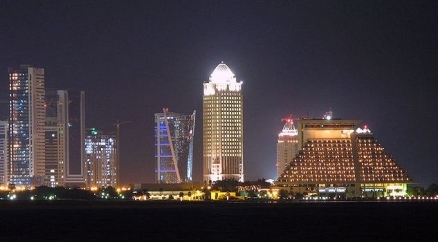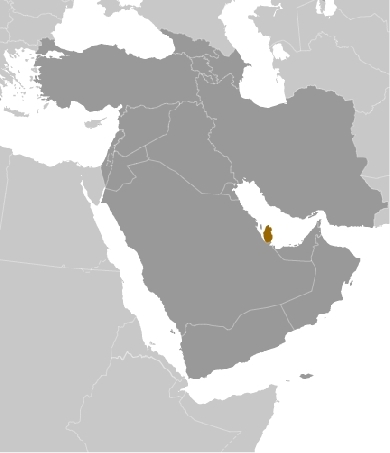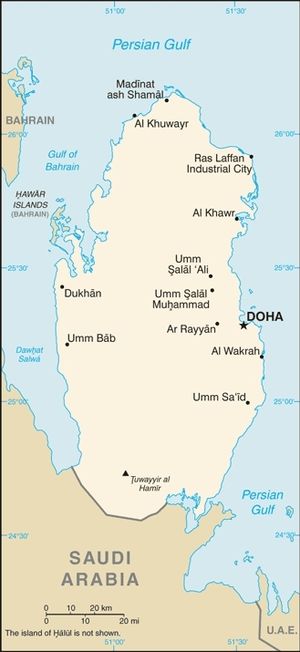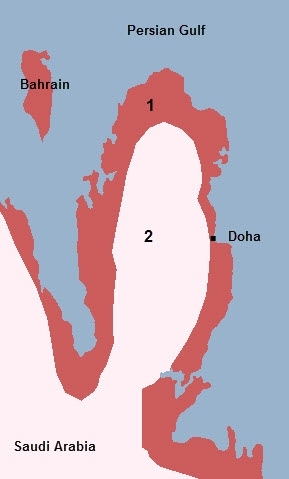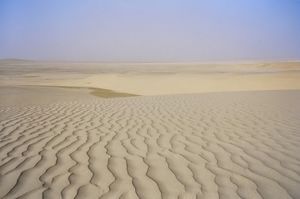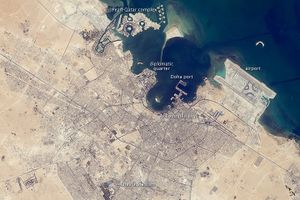Qatar (About the EoE)
Contents
Qatar
Countries and Regions of the World Collection 
Qatar is a nation of nearly two million people people in the Middle East; a peninsula bordering the Persian Gulf and Saudi Arabia.
Its major environmental issues include limited natural freshwater resources which give rise to an increasing dependence on large-scale desalination facilities.
Haze, dust storms, and sandstorms are common.
Ruled by the Al Thani family since the mid-1800s, Qatar transformed itself from a poor British protectorate noted mainly for pearling into an independent state with significant oil and natural gas revenues.
During the late 1980s and early 1990s, the Qatari economy was crippled by a continuous siphoning off of petroleum revenues by the Amir, who had ruled the country since 1972. His son, the current Amir Hamad bin Khalifa Al Thani, overthrew him in a bloodless coup in 1995.
In 2001, Qatar resolved its longstanding border disputes with both Bahrain and Saudi Arabia.
As of 2007, oil and natural gas revenues had enabled Qatar to attain the highest per capita income in the world. Qatar has not experienced the level of unrest or violence seen in other Near Eastern and North African countries in 2010-11, due in part to its immense wealth.
Qatar's international image is bolstered in part by the Doha-based Al Jazirah news network, which has provided comprehensive coverage of the Near East and North African Arab revolutions. Additionally, Qatar played a significant role in the Libyan revolution by pressing the Gulf Cooperation Council and the Arab League to assist the Libyan rebel movement.
Geography
Location: Middle East, peninsula bordering the Persian Gulf and Saudi Arabia
Geographic Coordinates: 25 30 N, 51 15 E
Area: 11,586 sq km
Land Boundaries: 60 km (with Saudi Arabia)
Coastline: 563 km
Maritime Claims:
Natural Hazards: haze, dust storms, sandstorms common
Terrain: mostly flat and barren desert covered with loose sand and gravel. The highest point is Tuwayyir al Hamir (103 m).
Climate: arid; mild, pleasant winters; very hot, humid summers
Ecology and Biodiversity
The coast areas of Qatar are included within the Persian Gulf desert and semi-desert ecoregion (1) which comprises part of the Eastern Province of Saudi Arabia, including its entire coastline along the Arabian Gulf, as well as Bahrain island, the coastline of Qatar and a small stretch of coastline belonging to the Abu Dhabi emirate of the United Arab Emirates (UAE). In the north, much of Kuwait is included. An inland finger projects south from Kuwait towards the great sand desert that dominates all of southern Arabia, the Rub'al-Khali.
The ecoregion is essentially a low desert plain extending from the Arabian Gulf coast westwards and inland towards Dahna, an area of high red-brown dunes rising above the surrounding plains. Its geology is of sedimentary marine deposits laid down during the late Tertiary, when the area was subject to intermittent submergence and deposition of sediments. This is very different from the ancient Precambrian complex of igneous and metamorphic rocks forming the western half of the Arabian Peninsula. Presenting some surface relief are various sedimentary formations although all are considerably eroded.
The interior of Qatar in included within the Arabian Desert and East Sahero-Arabian xeric shrublands ecoregion (2). This the largest ecoregion of the Arabian Peninsula, stretching from the Yemeni border to the Arabian Gulf and from Oman to Jordan and Iraq. Within this area lies a vast wilderness of sand, ‘a desert within a desert so enormous and so desolate that even the Arabs call it the Rub’al-Khali or the Empty Quarter’. It is probably the biggest continuous body of sand anywhere in the world, with an area of over 500,000 square kilometers (km2), or about the size of France. Egypt’s Sinai desert falls within this area, as well as much of southern and eastern Jordan, western Iraq, and northern Saudi Arabia. Bordering the Arabian Gulf, there is an extension into Qatar and, further east, the region covers almost all of Abu Dhabi in the United Arab Emirates (UAE). The Rub’al-Khali crosses over from Saudi Arabia into western Oman and eastern Yemen.
In Qatar and Bahrain terrestrial wildlife species diversity is low and there are few, if any, endemics. Most of Qatar, with its flat desert and scanty vegetation, supports only a sparse and restricted avifauna. Of 255 species recorded in the country, about 23 breed there, 78 are winter visitors and 104 are regular migrants. Bahrain was believed to be connected to the mainland of Arabia until 6,000 B.C. and its subsequent separation is cited as a reason for the low diversity of mammalian fauna.
In Qatar, nature conservation is the responsibility of the Environment Protection Committee (EPC). Research into fauna and flora is also conducted by the Scientific and Applied Research Centre of Qatar University, but there are no protected areas for nature conservation.
People and Society
Population: 1,951,591 (July 2012 est.)
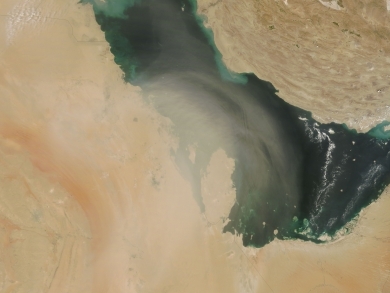
Natives of the Arabian Peninsula, many Qataris are descended from a number of migratory tribes that came to Qatar in the 18th century from the neighboring areas of Nejd and Al-Hasa. Some came from neighboring Gulf emirates and others are descended from Persian merchants. Most of Qatar's 1.7 million inhabitants live in Doha, the capital. Foreigners with temporary residence status make up over three-fourths of the population. Foreign workers comprise more than 90% of the total labor force. Most are South and Southeast Asians, Egyptians, Palestinians, Lebanese, Syrians, and Iranians. About 12,000 private U.S. citizens reside in Qatar.
For centuries, the main sources of wealth were pearling, fishing, and trade. At one time, Qataris owned nearly one-third of the Persian Gulf fishing fleet. With the Great Depression and the introduction of Japan's cultured-pearl industry, pearling in Qatar declined drastically.
Most Qataris are Sunni Muslims. Islam is the official religion, and Islamic jurisprudence is the official basis of Qatar's legal system, although civil courts have jurisdiction over commercial law. Arabic is the official language, but English is more widely spoken. Education is compulsory and free for all government employees' children from 6-16 years old. Qatar has a high literacy rate.
Ethnic Groups: Arab 40%, Indian 18%, Pakistani 18%, Iranian 10%, other 14%
Age Structure:
0-14 years: 21.8% (male 95,240/female 89,446)
15-64 years: 76.7% (male 460,673/female 189,914)
65 years and over: 1.5% (male 7,311/female 5,432) (2011 est.)
Population Growth Rate: 4.93% (2012 est.)
Birthrate: 10.23 births/1,000 population (2012 est.)
Death Rate: 1.55 deaths/1,000 population (July 2012 est.)
Net Migration Rate: 40.62 migrant(s)/1,000 population (2012 est.)
Life Expectancy at Birth: 78.09 years
male: 76.11 years
female: 80.12 years (2012 est.)
Total Fertility Rate: 1.93 children born/woman (2012 est.)
Languages: Arabic (official), English commonly used as a second language
Literacy (age 15 and over can read and write): 89% (2004 census)
Urbanization: 96% of total population (2010) growing at an annual rate of changes of 1.6% (2010-15 est.)
History
Qatar has been inhabited for millennia. Several families, including branches of the Bani Naim, lived in the peninsula, with the Al Thani and Al Misnad clans becoming the strongest. The Al Khalifa family (which now rules Bahrain) largely dominated the area until 1868 when, at the request of Qatari nobles, the British negotiated the termination of the Khalifa claim, except for the payment of tribute. The tribute ended when the Ottoman Empire occupied Qatar in 1872. When the Ottomans left at the beginning of World War I, the British recognized Sheikh Abdullah bin Jassim Al Thani as ruler. The 1916 treaty between the United Kingdom and Sheikh Abdullah was similar to those entered into by the British with other Gulf principalities. Under it, the ruler agreed not to dispose of any of his territory except to the U.K. and not to enter into relationships with any other foreign government without British consent. In return, the British promised to protect Qatar from all aggression by sea and to lend their good offices in case of a land attack. A 1934 treaty granted more extensive British protection.
In 1935, a 75-year oil concession was granted to the Qatar Petroleum Company, a subsidiary of the Iraq Petroleum Company, which was owned by Anglo-Dutch, French, and U.S. interests. High-quality oil was discovered in 1940 at Dukhan, on the western side of the Qatari peninsula. However, the start of WWII delayed exploitation of Qatar's oil resources, and oil exports did not begin until 1949.
During the 1950s and 1960s gradually increasing oil revenues brought prosperity, rapid immigration, substantial social progress, and the beginnings of Qatar's modern history. When the U.K. announced a policy in 1968 (reaffirmed in March 1971) of ending the treaty relationships with the Gulf sheikdoms, Qatar joined the other eight states then under British protection (the seven trucial sheikdoms--the present United Arab Emirates--and Bahrain) in a plan to form a union of Arab emirates. By mid-1971, as the termination date of the British treaty relationship (end of 1971) approached, the nine still had not agreed on terms of union. Accordingly, Qatar declared independence as a separate entity and became the fully independent State of Qatar on September 3, 1971.
In February 1972, the Heir Apparent, Sheikh Khalifa bin Hamad, deposed his cousin, Amir Ahmad, and assumed power. Key members of the Al Thani family supported this move, which took place without violence or signs of political unrest.
On June 27, 1995, the Deputy Amir, Sheikh Hamad bin Khalifa, deposed his father Amir Khalifa in a bloodless coup. An unsuccessful counter-coup was staged in 1996. The Amir and his father are now reconciled, though some supporters of the counter-coup remain in prison. The Amir announced his intention for Qatar to move toward democracy and has permitted a freer and more open press and municipal elections as a precursor to expected parliamentary elections. Qatari citizens approved a new constitution via public referendum in April 2003, which came into force in June 2005.
For years, both Qatar and Bahrain claimed ownership of the Hawar Islands. The case was eventually referred to the International Court of Justice (ICJ) in The Hague. The ICJ issued a ruling in June 2001, which both sides accepted. In the agreement Bahrain kept the main Hawar Island but dropped claims to parts of mainland Qatar, while Qatar retained significant maritime areas and their resources.
Government
The head of state is the Amir, and the right to rule Qatar is passed on within the Al Thani family, specifically to the current Amir’s sons. Shaykh Tamim bin Hamad, the Amir’s second son by Shaykha Moza bint Nasir al-Misnad, is the Heir Apparent and Deputy Amir, and has no rivals for succession. Politically, Qatar is evolving from a traditional society to one based on more formal and democratic institutions to meet the requirements of social and economic progress. The country's constitution formalizes the hereditary rule of the Al Thani family, but it also establishes an elected legislative body and makes government ministers accountable to the legislature. In current practice, the Amir's role is influenced by continuing traditions of consultation, rule by consensus, and the citizen's right to appeal personally to the Amir. The Amir, while directly accountable to no one, cannot violate the Shari'a (Islamic law) and, in practice, must consider the opinions of leading families and the religious establishment.
The opinions of the people are institutionalized in the Advisory Council, an appointed body that assists the Amir in formulating policy. Elections in 1999, in which both men and women participated, resulted in the formation of a municipal council. One woman candidate was elected to the municipal council in 2003. Municipal elections were held for the fourth time in 2011, and Advisory Council elections will be held for 2013.
There has been no serious challenge to Al Thani rule. As the most visible sign of the move toward openness, the Al Jazeera satellite television station based in Qatar is considered the most free and unfettered broadcast source in the Arab world. In practice, Al Jazeera rarely criticizes the ruling Al Thani family or addresses Qatar’s domestic issues.
Government Type: Emirate
Capital: Doha - 427,000 (2009)
Administrative divisions: 7 municipalities (baladiyat, singular - baladiyah); Ad Dawhah, Al Khawr wa adh Dhakhirah, Al Wakrah, Ar Rayyan, Ash Shamal, Az Za'ayin, Umm Salal
Independence Date: 3 September 1971 (from the UK)
Legal System: mixed legal system of civil law and Islamic law (in family and personal matters). Qatar has not submitted an International Court of Justice (ICJ) jurisdiction declaration; and is a non-party state to the International criminal court (ICCt).
The old and new zones of Doha, the capital city of Qatar, are clearly visible from the International Space Station. The old city comprises the ancient bazaar, or Souq, near the dhow harbor, which is still used today for traditional Arab sailing vessels. Modern port facilities have sprung up to the east of the Souq.
Subsequent developments have sprouted progressively further from the ancient center, with ring roads concentrically arranged around it. The diplomatic quarter is reached via the waterfront Corniche promenade, north of the old city. Further away, an extensive marina known as West Bay Lagoon, with boating access to the Persian Gulf, stands out (image top).
Qatar’s new artificial island, known as the Pearl-Qatar, is under construction with 32 kilometers of new coastline just offshore of West Bay Lagoon. This development is intended mainly as a residential zone, with themes based on Arabic, Mediterranean, and European cultures. The Pearl-Qatar is so named because it is being built on one of Qatar’s historical pearl diving sites. A string of small islands built along the outer margin is intended to recall the pearl-diving culture of the nation’s past.
Source: NASA
International Environmental Agreements
Qatar is party to international agreements on: Biodiversity, Climate Change, Climate Change-Kyoto Protocol, Desertification, Endangered Species, Hazardous Wastes, Law of the Sea, Ozone Layer Protection, and Ship Pollution.
Water
Total Renewable Water Resources: 0.1 cu km (1997)
Freshwater Withdrawal: 0.29 cu km/yr (24% domestic, 3% industrial, 72% agricultural)
Per Capita Freshwater Withdrawal: 358 cu m/yr (2000)
Agriculture
Agricultural products: fruits, vegetables; poultry, dairy products, beef; fish
Irrigated Land: 130 sq km (2008)
Resources
Natural Resources: petroleum, natural gas, fish
Land Use:
arable land: 1.64%
permanent crops: 0.27%
other: 98.09% (2005)
Economy
Oil formed the cornerstone of Qatar's economy well into the 1990s and still accounts for about 62% of total government revenue. In 1973, oil production and revenues increased sizably, moving Qatar out of the rank of the world's poorest countries and providing it with one of the highest per capita incomes. In 2007, Qatar's per capita income of nearly $67,000 was the fifth-highest in the world.
Qatar's economy suffered a downturn from in the mid-1990s. Lower Organization of Petroleum Exporting Countries (OPEC) oil production quotas, a fall in oil prices, and the generally unpromising outlook on international markets reduced oil earnings. In turn, the Qatari Government cut spending plans to match lower income. The resulting recessionary local business climate caused many firms to lay off expatriate staff. With the economy recovering in the late 1990s, expatriate populations have grown again.
As of 2007, oil production was around 835,000 barrels a day (bpd), and was expected to reach 1.1 million bpd by 2009. At the current production pace, oil reserves are expected to last more than 40 years. Moreover, Qatar's proven reserves of gas are the third-largest in the world, exceeding 900 trillion cubic feet (14% of the world's total proven gas reserves). Qatar shares with Iran the largest single non-associated gas field in the world, the North Field. Qatar is the world's largest producer of liquefied natural gas (LNG), with a capacity of more than 31 million metric tons per annum (mmta) as of 2007. By 2010, Qatar produced more than 77 mmta for LNG exports, accounting for over one-third of the world's LNG supply.
The 1991 completion of the $1.5-billion Phase I of the North Field gas development project strongly boosted the economy. In 1996, Qatar began exporting liquefied natural gas to Japan. Further phases of North Field gas development costing billions of dollars are in various stages of planning and development, and Qatar has concluded agreements with the U.A.E. to export gas via pipelines and to Spain, Turkey, Italy, the U.S., France, South Korea, India, China, Taiwan, and the U.K. via ship. However, the government halted any further expansion of gas production until 2010, as it assessed its plans for future exploitation of the field.
Qatar's natural gas liquefaction facilities and related industries are located in Ras Laffan Industrial City, site of the world's largest LNG exports of more than 31 million metric tons per year. Qatar's heavy industrial base, located in Messaieed, includes a refinery with a 140,000 bpd capacity, a fertilizer plant for urea and ammonia, a steel plant, and a petrochemical plant, and several new petrochemical plants will be built in the coming years. All these industries use gas for fuel. Most are joint ventures between U.S., European, and Japanese firms and the state-owned Qatar Petroleum (QP). The U.S. is the major equipment supplier for Qatar's oil and gas industry, and U.S. companies are playing a major role in the development of the oil and gas sector and petrochemicals.
The country's economic growth has been stunning. Qatar's nominal GDP, estimated to be $129 billion for 2010, has recently been growing at an average of 15%, with an inflation-adjusted 2010 growth rate estimated at 17%. Qatar's 2007 per capita GDP was $138,000, the highest in the world. The Qatari Government's strategy is to utilize its wealth to generate more wealth by diversifying the economic base of the country beyond hydrocarbons.
Qatar pursues a program of "Qatarization," under which all joint venture industries and government departments strive to move Qatari nationals into positions of greater authority. Growing numbers of foreign-educated Qataris, including many educated in the U.S., are returning home to assume key positions formerly occupied by expatriates. In order to control the influx of expatriate workers, Qatar has tightened the administration of its foreign manpower programs over the past several years. Security is the principal basis for Qatar's strict entry and immigration rules and regulations.
Despite the global financial crisis, Qatar has prospered in the last several years - in 2010 Qatar had the world's highest growth rate. Qatari authorities throughout the crisis sought to protect the local banking sector with direct investments into domestic banks. GDP rebounded in 2010 largely due to the increase in oil prices.
Economic policy is focused on developing Qatar's nonassociated natural gas reserves and increasing private and foreign investment in non-energy sectors, but oil and gas still account for more than 50% of GDP, roughly 85% of export earnings, and 70% of government revenues.
Oil and gas likely have made Qatar one of the highest per-capita income country - second only to Liechtenstein - and the country with the lowest unemployment.
Qatar's successful 2022 world cup bid will likely accelerate large-scale infrastructure projects such as Qatar's metro system and the Qatar-Bahrain causeway.
GDP: (Purchasing Power Parity): $181.7 billion (2011 est.)
GDP: (Official Exchange Rate): $173.2 billion (2011 est.)
GDP- per capita (PPP): $102,700 (2011 est.) (Second highest in the world)
GDP- composition by sector:
agriculture: 0%
industry: 79%
services: 20.9% (2011 est.)
Industries: liquefied natural gas, crude oil production and refining, ammonia, fertilizers, petrochemicals, steel reinforcing bars, cement, commercial ship repair
Currency: Qatari rials (QAR)
